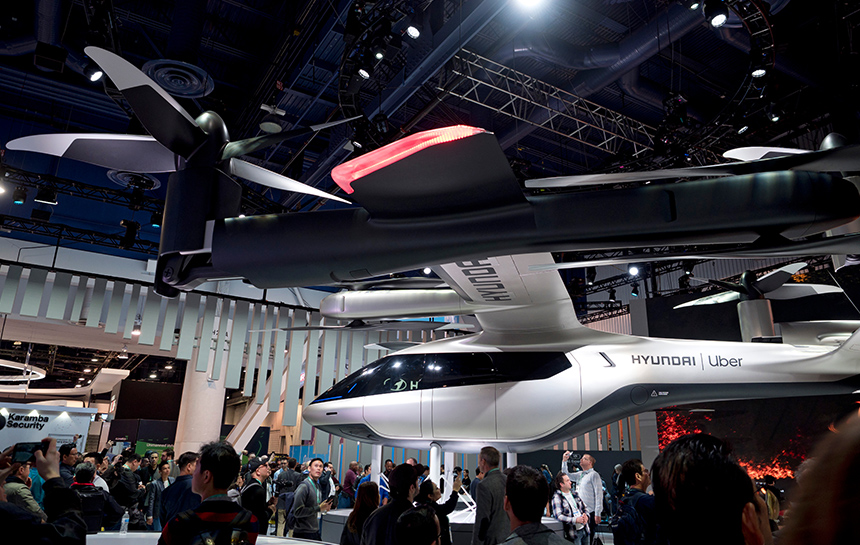Until now, only billionaires, world leaders, and James Bond villains flew to work, but someday soon, you too may have a faster commute: many companies around the world are hard at work on electric vertical takeoff and landing (eVTOL) aircraft, essentially super-sized drones designed to whisk two to four people from one side of a city to another at 160 km per hour.
From startups to some of biggest names in aviation, automotive manufacturing, and technology, at least 100 companies are now betting that in the relatively near future, eVTOL aircraft will become an important part of urban transportation, freight, and public safety. Airbus, Bell, Boeing, Embraer, Geely, Honey, Toyota, Google, Intel, Tencent, and Uber are all in the game in one way or another, according to General Aviation News.
Uber Elevate, the flight-focused division of the ride sharing giant, recently announced plans to roll out commercial air taxi services as early as 2023. Morgan Stanley, the investment bank that made important early calls on the growth of the Internet, has forecast that autonomous flying vehicles for delivering passengers and cargo, and for other purposes, could become a $1.5 trillion business by 2040.
Others are less confident that eVTOL will happen anytime soon, at least as a mode of passenger travel. “We are quite skeptical,” says Arij Van Berkel. The Amsterdam-based research director of Lux Research, an independent research and advisory firm, says a variety of major challenges must be resolved first, including the development of sufficiently powerful batteries and the regulation of urban air space.
Even the most bullish concede that there is a lot of work to be done. Just as it took decades to make the world safe for the automobile – to build the dense network of paved streets, consistent national road signs, traffic lights, driver’s licenses, gas stations, and regulatory systems that became synonymous with the 20th century –analysts say the 21st century’s urban aeronautic ecosystem will require a variety of new elements, many of which are still works in progress.
Infrastructure
One of the biggest challenges is infrastructure. With many people in the air at once, most forecasters predict the new aircraft will need to follow very restricted pathways. “Essentially, cities will need to create highways in the skies,” says van Berkel.
Particularly in the beginning, the scenario most often discussed is for an air taxi service that flies from vertical airport A to vertical airport B, along a well-defined corridor. In the end, most descriptions sound less like the Jetsons and more like a ski lift without the cables.
Defining lanes, and developing an air traffic control system capable of tracking thousands of large and small manned and unmanned drones, will take time. Sensors will need to be installed too to monitor potentially hazardous areas, such as urban canyons that might create a wind shear risk, according to Robin Lineberger, global and US aerospace and defense leader for Deloitte, the consultancy, at McLean, Va.
What happens after you arrive at your destination is another concern: you could easily fly across Los Angeles or Shanghai in ten minutes only to land somewhere that is still miles from your destination.
Consumer confidence
Consumer confidence is a second crucial issue. Like water taxis in Venice and helicopters in Sao Paolo, flying taxis could be very viable, says Jagdish Sheth, a professor of marketing at Emory University’s Goizueta Business School and noted corporate strategist. But although it is probably technically feasible, he doesn’t think they should begin with driverless eVTOLs. At least at first, people will want a pilot to give them a greater sense of security.
Technology
But the biggest challenges, are technical, van Berkel insists, citing noise and battery power as important problems that have yet to be resolved.
Deloitte’s Lineberger, on the other hand, doesn’t think noise will be a major problem. He says that eVTOL designs are already much quieter than helicopters, because the capacity of the rotors to adjust their angle means they require 50% less energy to operate than a traditional fixed propeller, and don’t need to break the sound barrier to stay aloft.
Producing powerful enough batteries could be more of a difficulty. Although batteries are 5-8% more efficient every year, Van Berkel argues that lithium-ion batteries have a long way to go before they are powerful enough. Solid-state batteries would be better, but even those, he argues, won’t be good enough for at least 10 more years. Even when they do mature, Van Berkel’s bet is that electric flight will be developed first for mid-sized hybrid planes for longer-range inter-city flights. At the smaller end, other applications are likely to develop first, he believes, such as remote inspection drones for electric lines and bridges.
Who wins?
Assuming, however, that these issues are solvable, who is likely to win – one of the many startups or an established aviation company?
Each category has its own set of advantages and disadvantages, says Deloitte’s Lineburger.
On the one hand, the startups have an advantage in their lack of legacy thinking and cost structure, say Lineberger and other industry experts.
The upstarts should also have a production advantage, as electric engines are much less complicated machines. The Tesla drive train has 17 moving parts compared to the 200 parts of an internal combustion engine drive train, according to the company. For the majors, whose business models are to an extent all razor blade strategies in which most of the profit is in service and spare parts, this will require some entirely new thinking.
Although many startups would like to be the Tesla of the air, van Berkel doesn’t think they will succeed. “A lot of them, we think, are dreaming to make a breakthrough like Tesla did…to a certain extent, that is good, that is how you get a business started – you need some bold moves to make it happen – but we think it’s too early for bold moves.”
The old guard also knows something about bringing aircraft to market. The incumbents should not be underestimated, Scott D. Anthony, a senior partner at Innosight in Singapore and noted innovation expert, warns, pointing to the growing challenges faced by Tesla Motors.
“No doubt [Tesla] helped to agitate the electrification market, but the incumbents are certainly not sitting idly by,” he wrote in an email. “It has developed very clever technology, managed relationships with governments exceedingly well, and built up a great brand. But now it has to fight against incumbents who have everything to lose if the world tips from internal combustion engines to electric, and have plenty of capabilities to bring to the table.”
The established aviation companies are potentially in a similar position, and unlike their startup competitors, also have extensive experience working with regulators. “Startups have knowledge of the technology but have never been through the Federal Aviation Administration certification process,” Lineberger explained.
In the end, Anthony thinks, bigger will prevail. “I would suspect the ultimate winner in the space is indeed likely to be an established company,” Anthony says, because “success will require mastering mass production and working closely with regulatory agencies, which is a hard set of capabilities for a startup to master.”
In regional terms, Asia appears to have the advantage. First, two startups in particular – EHang and Yuneec – have attracted lot of attention at recent eVTOL conferences.
Second, the world’s most advanced battery technology is currently found in Japan and China, and China in particular seems determined to scale up its battery business, according to van Berkel.
Third, Sheth thinks Chinese companies will be able to get their certification approvals more quickly and won’t have a hard time attracting people interested in training to become the cabbies of the sky.
“I believe China has a huge home turf advantage,” Sheth wrote in an email. Having more than 100 cities with over 5 million people, it has a huge potential market. At the same time, he says, finding and training the many drivers they will need will be easier.
“If I were advising China, I would start in China, develop the flying talent thru a training academy (labor will be cheaper and approval process will be faster in China), and then gradually allow driverless flying taxi service,” he added. Once they’ve succeeded in their home market, they can eventually export abroad, following the Huawei model.
Disruptive Ion-novation
All these estimates are based on extrapolating today’s incremental gains, but progress seldom proceeds according to our straight-line prognostications.
One possibly disruptive breakthrough occurred a few months ago at the Massachusetts Institute of Technology in Cambridge, Mass. Inspired by the silent shuttlecraft on Star Trek that he watched as a boy, Steven Barrett, an associate professor of aeronautics and astronautics at MIT, recently launched a new kind of flying machine that has no moving parts, a solid-state propulsion system that doesn’t generate thrust with propellers or turbines, but through a wind generated by passing high-voltage electricity from thin electrodes to thick ones.
In November, Barrett’s 2.5 kg, 5-meter wingspan machine flew 12 seconds – coincidentally, the same flight time as that of the Wright Brothers’ 1903 maiden voyage.
The ionic flyer is silent and extraordinarily efficient: ionic wind produces 110 newtons of thrust per kilowatt, compared to the two newtons per kilowatt of a jet engine, according to an MIT release. (A newton is the amount of power needed to accelerate 1 kg of mass at the rate of 1 meter per second squared.)
Although there are any number of technical hurdles ahead, MIT quoted a senior scientist for Lockheed Martin as saying he believed that the technology, partly because of this high efficiency, “offers nearly miraculous potential.”




















